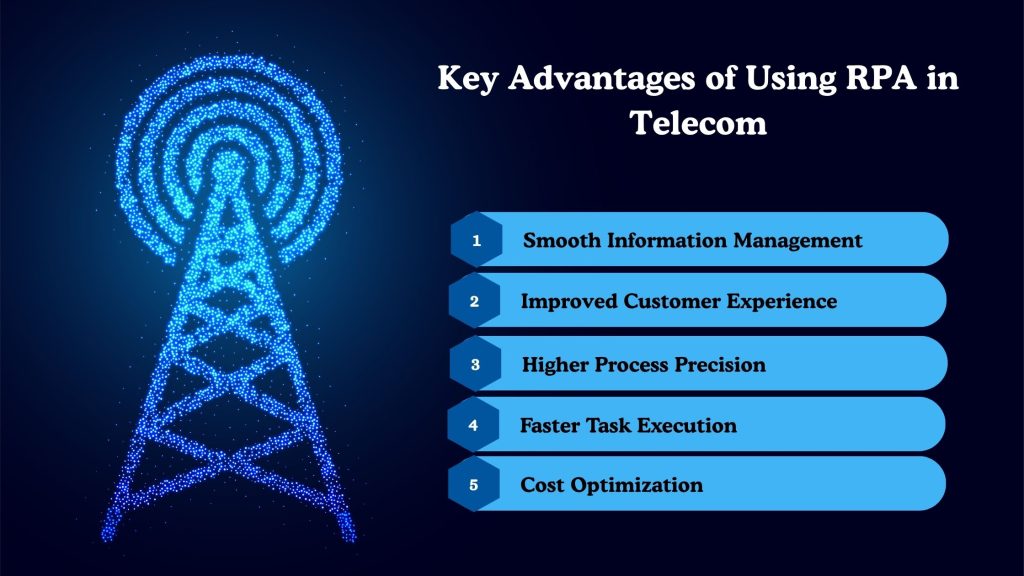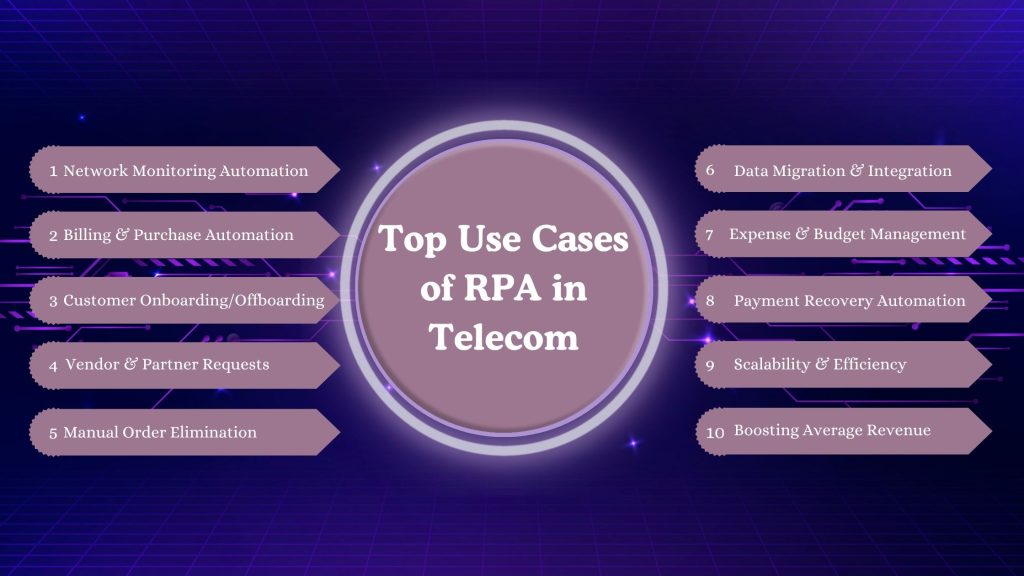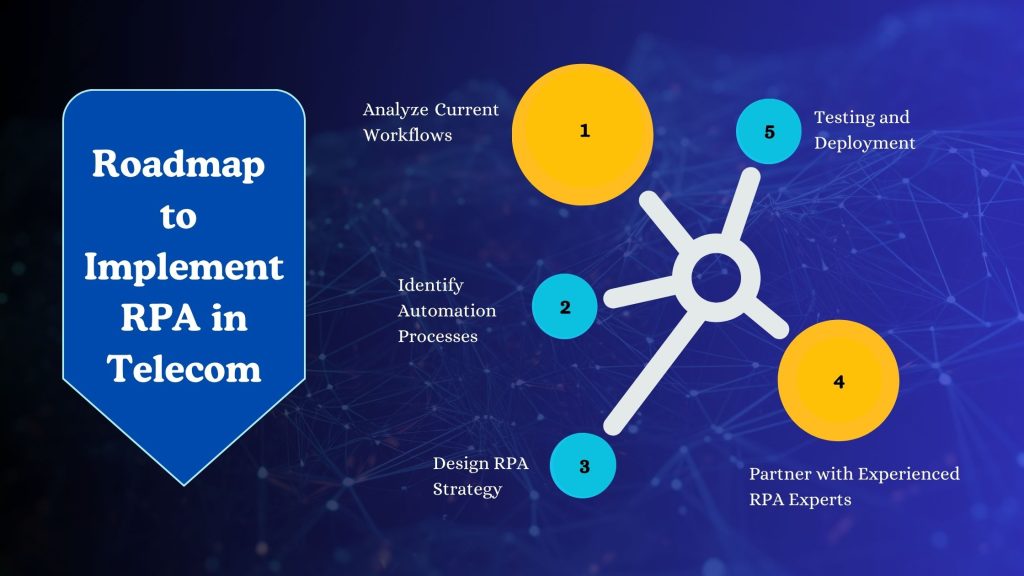
Robotic Process Automation in Telecom – Top 10 Real-World Use Cases

Blog Summary:
This guide delves into the transformative role of Robotic Process Automation (RPA) in the telecommunications industry. It explores how RPA enhances operational efficiency, reduces costs, and improves service delivery by automating repetitive tasks. Through real-world use cases and industry insights, the guide illustrates the strategic advantages of integrating RPA into telecom operations.
The telecommunications industry is undergoing a massive transformation, driven by the need for faster services, reduced costs, and seamless customer experiences. Companies are continually seeking ways to optimize operations while maintaining high service standards.
This is where Robotic Process Automation in Telecom comes into play. By automating repetitive, rule-based tasks, telecom providers can focus on strategic initiatives rather than manual processes.
With the rise of complex networks, vast data management requirements, and ever-growing customer demands, traditional methods are no longer sufficient. RPA in telecom industry allows organizations to streamline operations, reduce errors, and accelerate workflows, ultimately improving both efficiency and profitability.
Furthermore, automation in telecommunications offers a scalable solution to handle increasing workloads without proportional increases in cost or manpower.
From billing to network monitoring, and customer onboarding to vendor management, Robotic Process Automation in Telecom is proving to be a game-changer, enabling telecom companies to stay competitive in a rapidly evolving market.
Why Should Telecom Companies Adopt RPA Today?
Telecom companies operate in a highly competitive and fast-paced environment. Rising customer expectations, complex processes, and growing data volumes make it challenging to maintain efficiency while minimizing costs.
Adopting Robotic Process Automation in Telecom offers a practical solution to these challenges, enabling organizations to streamline operations, reduce errors, and achieve faster turnaround times.
Several factors make the adoption of RPA essential today:
Operational Inefficiencies
Manual workflows in telecom often involve repetitive tasks such as data entry, report generation, and service provisioning. These processes are time-consuming and prone to delays, affecting overall productivity.
RPA in the telecom industry automates such operations, ensuring tasks are completed accurately and swiftly, freeing employees to focus on higher-value activities.
Rising Business Costs
Maintaining large teams for repetitive tasks adds significant operational expenses. Implementing automation in telecommunications reduces dependence on manual labor, resulting in considerable cost savings while maintaining consistent service quality.
Frequent Human Errors
Human errors in data handling, billing, or customer management can lead to customer dissatisfaction and revenue leakage. By leveraging Robotic Process Automation in Telecom, telecom providers can minimize errors and maintain higher standards of accuracy and reliability across all operations.
Key Advantages of Using RPA in Telecom Operations

Integrating Robotic Process Automation in Telecom brings multiple benefits that directly impact operational efficiency, customer satisfaction, and overall business performance.
By automating routine tasks, telecom companies can focus on strategic growth and innovation.
Smooth Information Management
RPA enables seamless handling of vast amounts of data, from customer records to network logs. Automation ensures that information is accurately captured, organized, and easily retrievable, reducing delays and eliminating the need for manual data entry.
This capability strengthens decision-making and supports efficient operational planning.
Improved Customer Experience
With RPA in the telecom industry, service requests, billing queries, and customer onboarding processes are executed faster and more accurately. Customers experience fewer delays and errors, enhancing satisfaction and fostering loyalty.
Automation also allows telecom staff to dedicate more time to personalized services and problem-solving.
Higher Process Precision
Repetitive manual tasks often lead to errors, impacting service quality and revenue. Robotic Process Automation in Telecom ensures consistent execution of workflows, eliminating discrepancies in processes such as billing, reporting, and compliance, thereby maintaining high precision across operations.
Faster Task Execution
Automation accelerates routine processes, enabling telecom companies to respond to customer requests, process orders, and update records in record time. Faster execution not only improves operational efficiency but also gives telecom providers a competitive edge in the market.
Cost Optimization
By reducing reliance on manual labor, RPA helps telecom organizations cut operational costs. Resources previously spent on repetitive tasks can be redirected toward innovation and customer-focused initiatives, providing both financial savings and strategic advantages.
You Might Also Like:
Top 10 Use Cases of Robotic Process Automation in Telecom

Robotic Process Automation in Telecom is revolutionizing the way telecom companies handle critical operations. From network management to billing, RPA provides automation solutions that enhance efficiency, reduce errors, and improve overall service delivery.
Below are the top 10 use cases where RPA brings maximum value:
Network Monitoring Automation
RPA bots continuously monitor network performance, detecting issues such as downtime, slow connectivity, and service disruptions in real time. This automation reduces the dependency on manual monitoring, enabling telecom teams to act quickly and prevent customer complaints.
With automated alerts and reporting, network teams can prioritize issues and resolve them faster than traditional methods.
Moreover, RPA can integrate with existing network management tools to analyze trends and predict potential failures. This proactive approach ensures uninterrupted services, reduces maintenance costs, and enhances overall network reliability.
Implementing RPA in the telecom industry for network monitoring allows operators to maintain high service levels even with increasing network complexity.
Billing & Purchase Automation
Billing and purchase processes involve repetitive tasks such as invoice generation, payment tracking, and reconciliation. By implementing Robotic Process Automation in Telecom, companies can automate these tasks, reducing human errors and speeding up the billing cycle.
Automation ensures that invoices are generated accurately and delivered on time, improving customer satisfaction and financial accountability.
RPA also streamlines purchase order management, automatically verifying vendor details, tracking approvals, and updating procurement systems. This reduces administrative overhead and ensures seamless collaboration with suppliers.
Overall, billing and purchase automation help telecom providers optimize revenue management while saving operational costs.
Customer Onboarding/Offboarding
Customer onboarding involves account setup, service activation, and documentation, while offboarding requires proper account and service closure. Automation in telecommunications simplifies these processes by allowing RPA bots to handle repetitive tasks with high accuracy.
This reduces the time it takes for new customers to start using services and ensures a smooth, error-free offboarding.
Additionally, automated onboarding and offboarding improve compliance by ensuring that all regulatory requirements are consistently met. RPA also frees employees to focus on customer engagement and support, creating a better overall experience while maintaining operational efficiency.
Vendor & Partner Requests
Managing vendor or partner requests typically involves repetitive verification, approvals, and communication steps. In the telecom industry, RPA enables bots to handle these tasks automatically, ensuring requests are processed quickly and accurately.
This reduces delays, minimizes errors, and strengthens relationships with external stakeholders.
Automation also provides a clear audit trail for all vendor and partner interactions. By tracking every request and response, telecom companies can maintain transparency, improve accountability, and ensure timely collaboration without increasing manual effort.
Manual Order Elimination
Processing service orders manually can be slow and error-prone, impacting customer satisfaction. Robotic Process Automation in Telecom eliminates these inefficiencies by automating order verification, processing, and fulfillment.
Bots can handle large volumes of orders simultaneously, ensuring accuracy and reducing service delivery delays. Automated order management also allows telecom companies to scale their operations without increasing manpower in proportion.
This improves operational efficiency, accelerates response times, and ensures consistent service quality across all customer orders.
How Can You Boost Telecom Productivity
Robotic Process Automation in Telecom helps execute tasks faster increase accuracy and enhance service quality
Data Migration & Integration
Telecom operations often require moving large datasets between systems or integrating multiple platforms. RPA in the telecom industry automates data migration, ensuring accurate transfers without manual intervention.
Bots can map, validate, and upload data while maintaining integrity, reducing errors that often occur during manual migration.
Automation also simplifies system integration, enabling telecom providers to synchronize data across platforms in real time. This seamless flow of information improves decision-making, supports operational continuity, and reduces the burden on IT teams.
Expense & Budget Management
Expense and budget management involve tracking costs, generating reports, and ensuring adherence to financial plans. By using Robotic Process Automation in Telecom, companies can automate expense monitoring, report generation, and budget updates.
This reduces manual effort and ensures accurate financial tracking for better business decisions.
Automation also helps identify discrepancies, track overspending, and maintain financial compliance. By having RPA handle routine financial tasks, telecom teams can focus on strategic budgeting, cost optimization, and revenue growth initiatives.
Payment Recovery Automation
Managing overdue payments can be tedious and error-prone when done manually. RPA bots can automatically send reminders, track responses, and update payment records, ensuring timely follow-ups. This reduces staff workload and improves cash flow for telecom companies.
Additionally, automated payment recovery helps maintain customer relationships by providing consistent communication and reducing conflicts. By automating payment tracking in telecommunications, telecom providers can improve revenue assurance while minimizing human intervention.
Scalability & Efficiency
As telecom operations grow, handling higher workloads with the same manual resources becomes challenging. Robotic Process Automation in Telecom allows companies to scale their operations effortlessly. Bots can handle increased volumes of repetitive tasks, ensuring consistent performance without delays or errors.
This scalability also improves overall operational efficiency, allowing teams to focus on innovation and customer-focused initiatives. By leveraging RPA, telecom providers can expand services without significantly increasing costs or headcount.
Boosting Average Revenue
By automating repetitive tasks, minimizing errors, and accelerating service delivery, RPA in the telecom industry indirectly boosts average revenue per user (ARPU). Faster processes, accurate billing, and improved customer satisfaction all contribute to higher revenue streams.
Furthermore, automation frees resources to focus on strategic initiatives such as upselling, cross-selling, and service optimization. Overall, implementing RPA helps telecom companies maximize profitability while enhancing operational performance.
5-Phase Roadmap to Implement RPA in Telecom

Implementing Robotic Process Automation in Telecom requires a structured approach to ensure success and maximize benefits. Following a phased roadmap helps telecom companies seamlessly integrate RPA into their operations while minimizing risks.
Analyze Current Workflows
The first step is to assess existing workflows across various telecom functions, including billing, customer support, network management, and procurement. Understanding where bottlenecks, delays, or errors occur helps identify processes that can benefit most from automation.
A detailed workflow analysis ensures that RPA initiatives target high-impact areas, thereby maximizing operational efficiency and ROI.
Identify Automation Processes
Once workflows are analyzed, the next step is to pinpoint tasks suitable for automation. Repetitive, rule-based processes such as data entry, invoice generation, service provisioning, and report creation are ideal candidates.
Identifying these processes early ensures that RPA implementation focuses on tasks that provide tangible benefits while reducing manual workload.
Boost Telecom Efficiency with RPA
Transform your telecom operations with Robotic Process Automation in Telecom, streamline workflows, reduce errors, and enhance customer satisfaction.
Design RPA Strategy
After identifying the tasks to automate, a detailed RPA strategy is developed. This includes selecting the right automation tools, defining success metrics, and outlining integration requirements with existing systems.
A well-planned strategy ensures that RPA in the telecom industry aligns with business objectives and supports long-term scalability.
Partner with Experienced RPA Experts
Collaborating with experienced RPA providers or consultants can significantly enhance the success of implementation. Experts bring technical knowledge, industry best practices, and experience in handling complex telecom operations.
Partnering with skilled professionals ensures smoother deployment, faster adoption, and fewer implementation challenges.
Testing and Deployment
The final phase involves rigorous testing of automated workflows to ensure accuracy, reliability, and compliance. Once testing is complete, RPA bots are deployed across the identified processes.
Continuous monitoring and optimization are essential to promptly address issues and maintain high efficiency, ensuring the full benefits of Robotic Process Automation in Telecom are realized.
Transforming Telecom Efficiency Through BigDataCentric
Telecom companies looking to implement Robotic Process Automation in Telecom can benefit immensely from partnering with experienced technology providers like BigDataCentric. By leveraging advanced automation solutions, BigDataCentric helps telecom operators streamline workflows, reduce operational costs, and enhance service quality.
BigDataCentric offers end-to-end support, from identifying automation opportunities to deploying RPA bots across critical processes. With expertise in rpa use cases in telecom, the team ensures seamless integration with existing systems, enabling telecom providers to achieve faster task execution and higher operational precision.
Their tailored solutions empower organizations to scale efficiently while maintaining consistent performance.
Additionally, BigDataCentric focuses on delivering measurable business outcomes. By automating repetitive and time-consuming tasks, telecom companies can redirect their workforce toward strategic initiatives, improve customer experiences, and drive revenue growth.
With their deep industry knowledge and technical expertise, BigDataCentric plays a pivotal role in transforming telecom operations and maximizing the benefits of automation in telecommunications.
Looking to Boost Telecom Productivity?
Leverage Robotic Process Automation in Telecom to execute tasks faster, reduce manual effort, and improve overall efficiency.
Final Words
The adoption of Robotic Process Automation in Telecom is no longer optional—it has become a critical strategy for telecom companies striving to stay competitive. By automating repetitive and rule-based tasks, organizations can achieve higher operational efficiency, reduce errors, optimize costs, and deliver superior customer experiences.
From network monitoring and billing to customer onboarding and vendor management, RPA offers tangible benefits across multiple facets of telecom operations. With a structured roadmap and the right technology partner, companies can implement automation smoothly, scale efficiently, and unlock new growth opportunities.
Embracing RPA in telecom industry enables telecom providers to focus on innovation, strategic initiatives, and customer-centric services, driving long-term success in a rapidly evolving market.
FAQs
-
Which tool is used for RPA?
Popular RPA tools include UiPath, Automation Anywhere, Blue Prism, and Pega, which help automate repetitive business processes efficiently.
-
Can RPA reduce costs in telecom operations?
Yes, RPA reduces operational costs by automating repetitive tasks, minimizing errors, and improving workflow efficiency.
-
Is Robotic Process Automation suitable for small telecom operators?
Yes, even small telecom operators can benefit from RPA by optimizing processes and saving time and resources without heavy investment.
-
What are the three types of robotic systems?
The three types are industrial robots (for manufacturing), service robots (for customer support or tasks), and collaborative robots (cobots working with humans).
-
How long does it take to see results from RPA in telecom?
Results can typically be seen within a few weeks to a few months, depending on the complexity of processes and scale of implementation.

About Author
Jayanti Katariya is the CEO of BigDataCentric, a leading provider of AI, machine learning, data science, and business intelligence solutions. With 18+ years of industry experience, he has been at the forefront of helping businesses unlock growth through data-driven insights. Passionate about developing creative technology solutions from a young age, he pursued an engineering degree to further this interest. Under his leadership, BigDataCentric delivers tailored AI and analytics solutions to optimize business processes. His expertise drives innovation in data science, enabling organizations to make smarter, data-backed decisions.
Table of Contents
Toggle